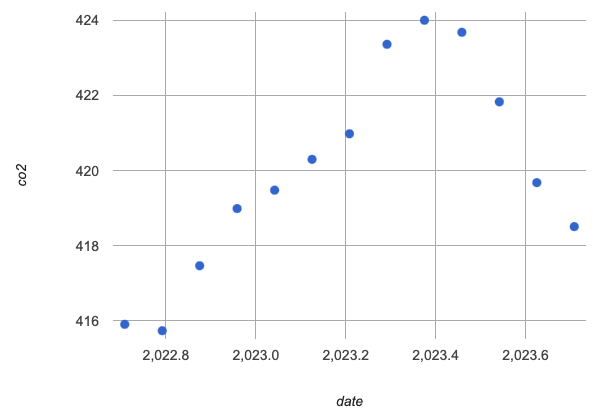This page relies on the Carbon Dioxide Starter File. Make sure you have it open on your computer!
Define Your Periodic Model
1 Define a periodic model using the values you computed for a, k, h and b on Modeling Recent Carbon Dioxide Levels.
Students horizontal shift estimates may vary slightly from this function definition.
Function Notation |
periodic - sin(x) = (amplitude (a) × sin( frequency (b) (x - horizontal shift (h) ))) + vertical shift (k) |
|
fun periodic-sin(x): ( * sin( * (x - ))) + end |
2 Then update the periodic-sin function definition in your starter file to match what you’ve just written.
★ Try translating the definition you wrote for periodic so that it uses cosine instead of sine:
Function Notation |
periodic - cos(x) = (amplitude (a) × cos( frequency (b) (x - horizontal shift (h)))) + vertical shift (k) |
|
fun periodic-cos(x): ( * cos( * (x - ))) + end |
Fit Your Periodic Model to the Data
3 Use fit-model to fit your periodic model to the data in the recent-table. What S-value do you get?
4 On the scatter plot below, make a sketch of what you see in pyret showing how the
|
5 Then fill in the blanks below to tell us what the model means. |
These materials were developed partly through support of the National Science Foundation, (awards 1042210, 1535276, 1648684, 1738598, 2031479, and 1501927).  Bootstrap by the Bootstrap Community is licensed under a Creative Commons 4.0 Unported License. This license does not grant permission to run training or professional development. Offering training or professional development with materials substantially derived from Bootstrap must be approved in writing by a Bootstrap Director. Permissions beyond the scope of this license, such as to run training, may be available by contacting contact@BootstrapWorld.org.
Bootstrap by the Bootstrap Community is licensed under a Creative Commons 4.0 Unported License. This license does not grant permission to run training or professional development. Offering training or professional development with materials substantially derived from Bootstrap must be approved in writing by a Bootstrap Director. Permissions beyond the scope of this license, such as to run training, may be available by contacting contact@BootstrapWorld.org.
